Selected Peer-Reviewed Publications
Below you will find a list of selected peer-reviewed publications that writers on this website contributed to, along with an abstract providing an overview of the research.

Considine, J., Eakins, J., Horgan, P., & Weir, C. (2024). Compensating Tendencies in Disciplinary Sanctions: The Case of Hurling. Journal of Sports Economics.
This paper investigates the presence of compensating tendencies in the awarding of free shots in hurling. Probit models are estimated to examine whether free shots awarded are determined by the score margin, net free count, and net card count at the time. In addition, the effect of large attendances and home games on these compensating tendencies is captured using interaction effects. Clear evidence of compensating tendency effects if the team is behind on the score margin or behind on the free count are found. When the game is played in front of large attendances, compensating tendencies based on the score margin are amplified. In contrast, there is no evidence of a home team bias in compensating tendencies based on the subset of games played at nonneutral venues. Although efforts should be made to minimize the compensating tendencies identified, administrators should tread carefully because the direction of the compensating tendencies are procompetition.
This paper investigates the presence of compensating tendencies in the awarding of free shots in hurling. Probit models are estimated to examine whether free shots awarded are determined by the score margin, net free count, and net card count at the time. In addition, the effect of large attendances and home games on these compensating tendencies is captured using interaction effects. Clear evidence of compensating tendency effects if the team is behind on the score margin or behind on the free count are found. When the game is played in front of large attendances, compensating tendencies based on the score margin are amplified. In contrast, there is no evidence of a home team bias in compensating tendencies based on the subset of games played at nonneutral venues. Although efforts should be made to minimize the compensating tendencies identified, administrators should tread carefully because the direction of the compensating tendencies are procompetition.
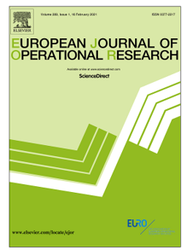
Butler D, Butler R, Farnell, A and Simmons, R (2024). COVID-19 infections and short-run worker performance: Evidence from European football. European Journal of Operational Research.
COVID-19 infections represent a recurrent source of workplace absenteeism impacting labour productivity. Using a unique matched employee-employer dataset, we consider the effects of the virus on the performance of highly valuable employees when returning to work: professional footballers in the top five European leagues. This offers a window to study job scheduling and managerial decision-making. We employ a difference-in-differences (DiD) model that compares the performance of infected players to a matched control group for game tasks that require physical exertion. Results suggest that per-minute performance is unaffected upon returning to play. This is likely due to effective management of minutes on the pitch. We carry out a battery of checks on the primary results to consider causal mechanisms outside of infection that could impact the results such as lockdown breaks, clusters within squads, and scheduling effects. The findings carry an optimistic message and specifically speak to managers supervising physical labour. If appropriately managed, infected workers can return to past performance levels.
The full paper can be accessed at here.
COVID-19 infections represent a recurrent source of workplace absenteeism impacting labour productivity. Using a unique matched employee-employer dataset, we consider the effects of the virus on the performance of highly valuable employees when returning to work: professional footballers in the top five European leagues. This offers a window to study job scheduling and managerial decision-making. We employ a difference-in-differences (DiD) model that compares the performance of infected players to a matched control group for game tasks that require physical exertion. Results suggest that per-minute performance is unaffected upon returning to play. This is likely due to effective management of minutes on the pitch. We carry out a battery of checks on the primary results to consider causal mechanisms outside of infection that could impact the results such as lockdown breaks, clusters within squads, and scheduling effects. The findings carry an optimistic message and specifically speak to managers supervising physical labour. If appropriately managed, infected workers can return to past performance levels.
The full paper can be accessed at here.
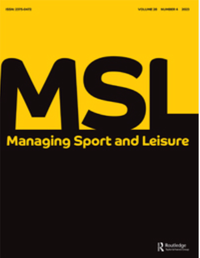
Fahy, R., Butler, D. and Butler, R. (2023). Broadcasting demand for Formula One: Viewer preferences for outcome uncertainty in the United States. Managing Sport and Leisure.
We explore the determinants of broadcasting demand for Formula One racing in the United States of America and pay specific attention to the relationship between outcome uncertainty and television viewership figures. Using implied probabilities derived from betting odds, we offer an approach to measuring outcome uncertainty that differs from those currently established in the Formula One broadcasting demand literature. We do not find any evidence to support the uncertainty of outcome hypothesis. On the contrary, viewers display a preference for less closely contested races. We find that scheduling and accessibility to live races are important determinants of viewership. Our results have practical implications and can guide the sport's administrators and television broadcasters seeking to understand a growing national market for F1 broadcasting.
The full paper can be access here.
We explore the determinants of broadcasting demand for Formula One racing in the United States of America and pay specific attention to the relationship between outcome uncertainty and television viewership figures. Using implied probabilities derived from betting odds, we offer an approach to measuring outcome uncertainty that differs from those currently established in the Formula One broadcasting demand literature. We do not find any evidence to support the uncertainty of outcome hypothesis. On the contrary, viewers display a preference for less closely contested races. We find that scheduling and accessibility to live races are important determinants of viewership. Our results have practical implications and can guide the sport's administrators and television broadcasters seeking to understand a growing national market for F1 broadcasting.
The full paper can be access here.
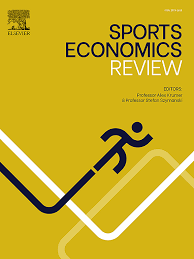
Butler D & Butler R, (2023). Ghost games and ex-post viewing preferences for the English Premier League: Evidence from YouTube highlights. Sports Economics Review
We ask if the move to play elite football (soccer) matches without spectators during the COVID-19 pandemic impacted online viewership. Using a new dataset from YouTube, we depart from the traditional ex ante approach to modelling football demand and investigate streaming preferences for known results in football. Our data is collected in real-time and considers English Premier League matches from 2019 to 2021 played both in front of crowds and behind closed doors. The results indicate increased viewership for matches played without crowds. The findings also allow a deeper understanding of direct demand for football as we identify motivators that make fans curious to view content after the fact. The research adds to our understanding of the effects of the pandemic on fan viewer behaviour and speaks to broadcasting firms developing digital extension strategies.
The full paper can be accessed here.
We ask if the move to play elite football (soccer) matches without spectators during the COVID-19 pandemic impacted online viewership. Using a new dataset from YouTube, we depart from the traditional ex ante approach to modelling football demand and investigate streaming preferences for known results in football. Our data is collected in real-time and considers English Premier League matches from 2019 to 2021 played both in front of crowds and behind closed doors. The results indicate increased viewership for matches played without crowds. The findings also allow a deeper understanding of direct demand for football as we identify motivators that make fans curious to view content after the fact. The research adds to our understanding of the effects of the pandemic on fan viewer behaviour and speaks to broadcasting firms developing digital extension strategies.
The full paper can be accessed here.

Butler D, Butler R, Maxcy, J and Woodworth, S. (2023). Outcome Uncertainty and Viewer Demand for Basic Cable Boxing. Journal of Sports Economics
We examine the uncertainty of outcome hypothesis and consider direct demand for professional boxing using a new dataset for basic cable broadcasts. Our analysis covers 103 broadcasts in the United States from February 2017 to February 2021 for Premier Boxing Champions (FOX) and Top Rank Boxing (ESPN). Using a generalized linear model, we estimate a demand function for basic cable broadcasts and place specific emphasis on adopting alternative measures of outcome uncertainty. We find no evidence that increasing balance between boxers increases viewership figures on basic cable broadcasts. Consistent with pay-per-view boxing viewership, our results demonstrate that bout quality impacts demand for cable broadcasts. Furthermore, we find no evidence of a declining viewership trend, a finding relevant to the industry given the general decrease in viewership trends for main events and pay-per-view broadcasts. Fans continue to demonstrate a preference for the welterweight division. The full paper can be found here.
We examine the uncertainty of outcome hypothesis and consider direct demand for professional boxing using a new dataset for basic cable broadcasts. Our analysis covers 103 broadcasts in the United States from February 2017 to February 2021 for Premier Boxing Champions (FOX) and Top Rank Boxing (ESPN). Using a generalized linear model, we estimate a demand function for basic cable broadcasts and place specific emphasis on adopting alternative measures of outcome uncertainty. We find no evidence that increasing balance between boxers increases viewership figures on basic cable broadcasts. Consistent with pay-per-view boxing viewership, our results demonstrate that bout quality impacts demand for cable broadcasts. Furthermore, we find no evidence of a declining viewership trend, a finding relevant to the industry given the general decrease in viewership trends for main events and pay-per-view broadcasts. Fans continue to demonstrate a preference for the welterweight division. The full paper can be found here.
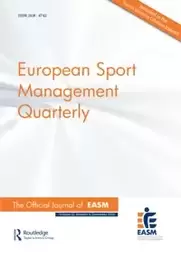
David Berri, David Butler, Giambattista Rossi, Rob Simmons & Conor Tordoff (2023) Salary determination in professional football: empirical evidence from goalkeepers. European Sport Management Quarterly.
We consider how elite European football clubs use available and measurable performance data to value personnel by focussing on the goalkeeper labour market. We test the determinants of goalkeeper pay and discuss if football clubs effectively separate goalkeeper performances from outfield players. Matching an exclusive salary dataset with rich performance measures, we estimate a Mincer-type salary model for a sample of 260 goalkeepers from five European football leagues (Premier League, Ligue 1, Bundesliga 1, Serie A and La Liga). Our dataset covers seven seasons from 2013/14 to 2019/20. We find that clubs use primitive defensive statistics to determine goalkeeper pay. Goalkeepers are paid based on co-production and team outcomes rather than individual workload. Also features of goalkeeper ball distribution positively affect salary - this indicates the importance of goalkeepers to initiating offensive moves. Our evidence suggests that decision-makers within clubs are not optimally decoupling individual performance from team qualities. As such, clubs could improve how they value a key team member. Identifying the failure to use advanced statistics is especially important as forming contracts in this setting is costly.
We consider how elite European football clubs use available and measurable performance data to value personnel by focussing on the goalkeeper labour market. We test the determinants of goalkeeper pay and discuss if football clubs effectively separate goalkeeper performances from outfield players. Matching an exclusive salary dataset with rich performance measures, we estimate a Mincer-type salary model for a sample of 260 goalkeepers from five European football leagues (Premier League, Ligue 1, Bundesliga 1, Serie A and La Liga). Our dataset covers seven seasons from 2013/14 to 2019/20. We find that clubs use primitive defensive statistics to determine goalkeeper pay. Goalkeepers are paid based on co-production and team outcomes rather than individual workload. Also features of goalkeeper ball distribution positively affect salary - this indicates the importance of goalkeepers to initiating offensive moves. Our evidence suggests that decision-makers within clubs are not optimally decoupling individual performance from team qualities. As such, clubs could improve how they value a key team member. Identifying the failure to use advanced statistics is especially important as forming contracts in this setting is costly.
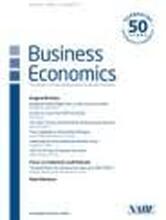
Butler, R (2022). An economist goes to the game: how to throw away $580 million and other surprising insights from the economics of sports.
Book Review. Paul Oyer’s “An Economist Goes to the Game: How to Throw Away $580 Million and Other Surprising Insights from the Economics of Sports” is a fun and highly enjoyable way to explore the brilliant world of economics through the lens of sport. Professor Oyer is the Mary and Rankine Van Anda Entrepreneurial Professor and Professor of Economics at Stanford Business School and a former editor-in-chief of the Journal of Labor Economics. The book takes readers on a journey through a collection of sports stories, introducing some of the world’s most famous athletes along the way, and demonstrates how core economic concepts are at the very heart of these multibillion-dollar industries. Oyer clearly has a passion for both and uses his deep understanding of economics to identify issues such as opportunity cost, prisoners’ dilemma, and gross domestic product. The full review can be found here.
Book Review. Paul Oyer’s “An Economist Goes to the Game: How to Throw Away $580 Million and Other Surprising Insights from the Economics of Sports” is a fun and highly enjoyable way to explore the brilliant world of economics through the lens of sport. Professor Oyer is the Mary and Rankine Van Anda Entrepreneurial Professor and Professor of Economics at Stanford Business School and a former editor-in-chief of the Journal of Labor Economics. The book takes readers on a journey through a collection of sports stories, introducing some of the world’s most famous athletes along the way, and demonstrates how core economic concepts are at the very heart of these multibillion-dollar industries. Oyer clearly has a passion for both and uses his deep understanding of economics to identify issues such as opportunity cost, prisoners’ dilemma, and gross domestic product. The full review can be found here.
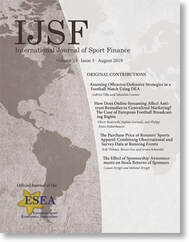
Butler D, and Coates D (2022). Position Premium in Major League Soccer. International Journal of Sports Finance
This research estimates the effect of specific player position on salary in Major League Soccer. We expand a mincer-style wage equation with indicators for precise roles as defined by the Football Manager™ simulation. Our salary data covers 1,174 salaries for the 2019 and 2020 seasons. We match this to 17 positions and consider generalist and specialist functions in wage determination. Estimating ordinary least squares and quantile regressions, we find that defensive salary penalties are incurred only by specific peripheral defensive and wing back positions. Premia exist for versatile, attacking midfield players. We show that multi-positional players—those that play in multiple positional zones—earn a premium. The findings bring nuance to any specialist-generalist debate as versatile defensive players incur a penalty whereas versatile attacking midfield players earn a premium. Practically, the results speak to player unions, intermediaries advising players on their developmental needs, and franchises who must optimize salary budgets.
This research estimates the effect of specific player position on salary in Major League Soccer. We expand a mincer-style wage equation with indicators for precise roles as defined by the Football Manager™ simulation. Our salary data covers 1,174 salaries for the 2019 and 2020 seasons. We match this to 17 positions and consider generalist and specialist functions in wage determination. Estimating ordinary least squares and quantile regressions, we find that defensive salary penalties are incurred only by specific peripheral defensive and wing back positions. Premia exist for versatile, attacking midfield players. We show that multi-positional players—those that play in multiple positional zones—earn a premium. The findings bring nuance to any specialist-generalist debate as versatile defensive players incur a penalty whereas versatile attacking midfield players earn a premium. Practically, the results speak to player unions, intermediaries advising players on their developmental needs, and franchises who must optimize salary budgets.
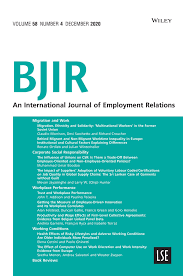
Butler D, Butler R and Simmons, R (2022). Contracts, Pay and Performance in the Sport of Kings: Evidence from Horse Racing. British Journal of Industrial Relations.
Using twenty year of data from 2000-2019 we explore the relationship between jockey pay and performance for flat racing in Great Britain. In essence, the work is an extension of Fernie and Metclaf (1999) and seeks to understand if performance-related pay schemes can raise worker productivity with much of this increase due to worker sorting. The beauty of horse racing in the context is that it allows us to consider variations in the power of performance-related pay contracts which can be rarely observed in other employment settings.
Unlike previous findings, we find no evidence of worker shirking when the power of incentive contracts is reduced through jockeys switching from complete performance-related pay scheme into a salaried (retainer) contract. Moreover, salary contracts result in legacy effects with superior performance continuing for elite jockeys even after their salary agreements have expired. Amongst other things, we argue this is due to a reduction in monitoring costs.
The full text is available here.
Using twenty year of data from 2000-2019 we explore the relationship between jockey pay and performance for flat racing in Great Britain. In essence, the work is an extension of Fernie and Metclaf (1999) and seeks to understand if performance-related pay schemes can raise worker productivity with much of this increase due to worker sorting. The beauty of horse racing in the context is that it allows us to consider variations in the power of performance-related pay contracts which can be rarely observed in other employment settings.
Unlike previous findings, we find no evidence of worker shirking when the power of incentive contracts is reduced through jockeys switching from complete performance-related pay scheme into a salaried (retainer) contract. Moreover, salary contracts result in legacy effects with superior performance continuing for elite jockeys even after their salary agreements have expired. Amongst other things, we argue this is due to a reduction in monitoring costs.
The full text is available here.
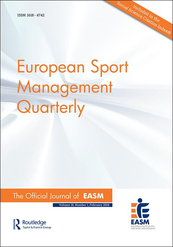
Butler D, Butler R and Maxcy, J (2022). New insights on the Louis-Schmeling paradox: determinants of demand for subscription and pay-per-view boxing. European Sport Management Quarterly.
Studies considering demand for professional boxing are almost completely absent from the Sport Management/Sports Economics literature. Little is known about consumer preferences for a sport which attracts global attention but is unique insofar as it is exempt from standard sporting institutions maintaining competitive balance. We use two new datasets to ask, what are the determinants of main event viewership (Nielsen ratings) and pay-per-views buys? In addressing this question we offer new insights on the uncertainty-of-outcome hypothesis and extend research on direct demand for individual sport.
We estimate generalised linear models, controlling for economic determinants, bout features, boxer popularity and scheduling factors. For main events, we find conflicting evidence to the uncertainty-of-outcome hypothesis. Fans show a preference for rematches, domestic boxers and heavier divisions. NFL broadcasts and earlier scheduling negatively impact viewership. For pay-per-views, we find a positive price effect.
The results offer new evidence that is contrary to the uncertainty-of-outcome hypothesis for an individual sport. The findings point to differences in consumer preferences between two sources of demand for the same sport. Practically, these can inform the strategic decision-making of broadcasters, promoters, advertisers and potential new broadcasting entrants.
The full paper can be found here.
Studies considering demand for professional boxing are almost completely absent from the Sport Management/Sports Economics literature. Little is known about consumer preferences for a sport which attracts global attention but is unique insofar as it is exempt from standard sporting institutions maintaining competitive balance. We use two new datasets to ask, what are the determinants of main event viewership (Nielsen ratings) and pay-per-views buys? In addressing this question we offer new insights on the uncertainty-of-outcome hypothesis and extend research on direct demand for individual sport.
We estimate generalised linear models, controlling for economic determinants, bout features, boxer popularity and scheduling factors. For main events, we find conflicting evidence to the uncertainty-of-outcome hypothesis. Fans show a preference for rematches, domestic boxers and heavier divisions. NFL broadcasts and earlier scheduling negatively impact viewership. For pay-per-views, we find a positive price effect.
The results offer new evidence that is contrary to the uncertainty-of-outcome hypothesis for an individual sport. The findings point to differences in consumer preferences between two sources of demand for the same sport. Practically, these can inform the strategic decision-making of broadcasters, promoters, advertisers and potential new broadcasting entrants.
The full paper can be found here.
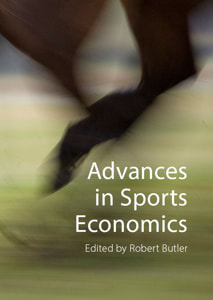
Advances in Sports Economics - Edited by Robert Butler
The data that professional sport generates, which is almost unparalleled in any other industry, provides a wealth of information for the economist to analyse. Sport offers economists the opportunity to study the behaviour, choices and outcomes of the decisions of players, referees, regulators and governments.
Advances in Sports Economics is a collection of newly commissioned essays that examine a wide range of different sports, including baseball, basketball, cricket, football, horse racing, rugby, tennis and Gaelic games. The contributors consider economic issues such as incentives, rule changes, labour markets, competition structure, gambling, gender equality, match official behaviour, superstar players, funding and sports infrastructure as well as interogating the methods and theories used in sports economics.
The essays showcase how the application of economic analysis can provide us with a better understanding of the mechanics of professional sport.
The book can be purchased here.
The data that professional sport generates, which is almost unparalleled in any other industry, provides a wealth of information for the economist to analyse. Sport offers economists the opportunity to study the behaviour, choices and outcomes of the decisions of players, referees, regulators and governments.
Advances in Sports Economics is a collection of newly commissioned essays that examine a wide range of different sports, including baseball, basketball, cricket, football, horse racing, rugby, tennis and Gaelic games. The contributors consider economic issues such as incentives, rule changes, labour markets, competition structure, gambling, gender equality, match official behaviour, superstar players, funding and sports infrastructure as well as interogating the methods and theories used in sports economics.
The essays showcase how the application of economic analysis can provide us with a better understanding of the mechanics of professional sport.
The book can be purchased here.
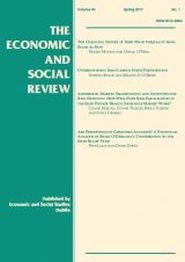
Butler D, Butler R, and Mullane, E (2021). Changing Competition Design and Spectator Turnout: Evidence from the League of Ireland. Economic and Social Review.
We contribute to the literature on demand for football by investigating the effect of variations in competition design on spectator turnout. We examine attendance in the League of Ireland Premier Division for two periods with alternative league formats, estimating club-fixed effects regressions. Our results show that the change did not increase average attendance. Many determinants of attendance are robust to the reorganisation and balance measures are consistent under both formats. Like past evidence from the League, habit, team form, scheduling and travel are important determinants. Our results speak to league administrators and club owners attempting to optimise revenues.
The full text is available here.
We contribute to the literature on demand for football by investigating the effect of variations in competition design on spectator turnout. We examine attendance in the League of Ireland Premier Division for two periods with alternative league formats, estimating club-fixed effects regressions. Our results show that the change did not increase average attendance. Many determinants of attendance are robust to the reorganisation and balance measures are consistent under both formats. Like past evidence from the League, habit, team form, scheduling and travel are important determinants. Our results speak to league administrators and club owners attempting to optimise revenues.
The full text is available here.
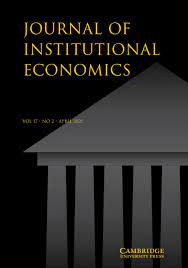
Butler D and Butler R (2021). The Evolution of the Football Jersey – An Institutional Perspective. Journal of Institutional Economics.
is paper explores the interaction of informal constraints on human behaviour by examining the evolution of English football jerseys. The jersey provides an excellent setting to demonstrate how informal constraints emerge from formal rules and shape human behaviour. Customs, approved norms and habits are all observed in this setting.
The commercialisation of football in recent decades has resulted in these informal constraints, in many cases dating back over a century, co-existing with branding, goodwill and identity effects. Combined these motivate clubs to maintain the status quo. As a result, club colours have remained remarkably resilient within a frequently changing landscape.
The full text is available here.
is paper explores the interaction of informal constraints on human behaviour by examining the evolution of English football jerseys. The jersey provides an excellent setting to demonstrate how informal constraints emerge from formal rules and shape human behaviour. Customs, approved norms and habits are all observed in this setting.
The commercialisation of football in recent decades has resulted in these informal constraints, in many cases dating back over a century, co-existing with branding, goodwill and identity effects. Combined these motivate clubs to maintain the status quo. As a result, club colours have remained remarkably resilient within a frequently changing landscape.
The full text is available here.
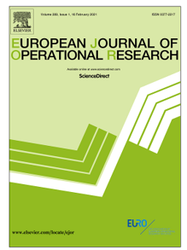
Butler D, Butler R and Eakins, J (2021). Expert performance and crowd wisdom: Evidence from English Premier League predictions. European Journal of Operational Research.
This paper analyses the forecasting accuracy of experts vis-à-vis laypeople over three seasons of English Premier League matches. We find that former professional football players have superior forecasting ability when compared to laypeople. The results give partial support to the view that a crowd forecast offers the greatest precision. Pundits generate a positive return while both the crowd and laypeople generate losses. As the prediction of multiple score outcomes represents a computationally difficult task, both groups display forecasting biases including a preference toward specific score forecasts. The results are relevant for those concerned with gambling behaviour if the forecasting strategies adopted here generalise to match betting markets.
The full text is available here.
This paper analyses the forecasting accuracy of experts vis-à-vis laypeople over three seasons of English Premier League matches. We find that former professional football players have superior forecasting ability when compared to laypeople. The results give partial support to the view that a crowd forecast offers the greatest precision. Pundits generate a positive return while both the crowd and laypeople generate losses. As the prediction of multiple score outcomes represents a computationally difficult task, both groups display forecasting biases including a preference toward specific score forecasts. The results are relevant for those concerned with gambling behaviour if the forecasting strategies adopted here generalise to match betting markets.
The full text is available here.
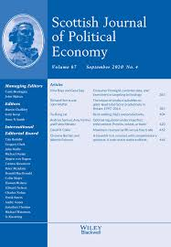
Butler, R, Massey, P and Lenten (2020). Bonus incentives and team effort levels: Evidence from the “Field”. Scottish Journal of Political Economy.
This study explores the effect of bonus incentive mechanisms with a focus on how such a scheme influences aggregate production levels of teams of workers, specifically. We identify this using data from a highly competitive setting in professional sport, which involves a unique tournament design rule in an elite European rugby competition. The modelling results demonstrate qualified evidence that introducing bonuses to encourage teams to score via the most‐difficult, highest‐reward mode, incentivizes teams to increase effort to earn the bonus, and without reducing production after the bonus is achieved.
The full text is available here.
This study explores the effect of bonus incentive mechanisms with a focus on how such a scheme influences aggregate production levels of teams of workers, specifically. We identify this using data from a highly competitive setting in professional sport, which involves a unique tournament design rule in an elite European rugby competition. The modelling results demonstrate qualified evidence that introducing bonuses to encourage teams to score via the most‐difficult, highest‐reward mode, incentivizes teams to increase effort to earn the bonus, and without reducing production after the bonus is achieved.
The full text is available here.
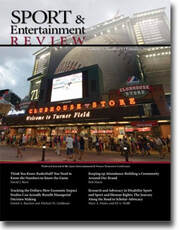
Butler D and Butler R (2020. ) Incentives and Unintended Consequences: Lessons from Sport. Sport and Entertainment Review.
This paper explores the relationship between changing incentives and unintended consequences in the context of the sports labor market and sports broadcasting. Appealing to two recently published studies, we demonstrate how the introduction of bonus points in rugby union, and intervention by broadcasting regulators in the European Union, have altered incentives and brought about consequences not envisioned. These examples are applicable across industries and demonstrate the need for caution when implementing what appear to be, minor modifications to conditions impacting employees and consumers.
The full paper is available here.
This paper explores the relationship between changing incentives and unintended consequences in the context of the sports labor market and sports broadcasting. Appealing to two recently published studies, we demonstrate how the introduction of bonus points in rugby union, and intervention by broadcasting regulators in the European Union, have altered incentives and brought about consequences not envisioned. These examples are applicable across industries and demonstrate the need for caution when implementing what appear to be, minor modifications to conditions impacting employees and consumers.
The full paper is available here.
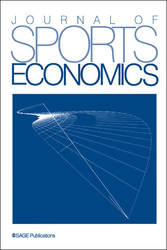
Butler, R & Massey, P (2019). Has competition in the market for subscription Sports broadcasting benefitted consumers? The case of the English Premier League. Journal of Sports Economics
This paper investigates the peculiar nature of competition in the broadcasting market for live English Premier League matches in the United Kingdom. Following the movement from free-to-air to subscription television in 1992, British Sky Broadcasting secured a monopoly on live broadcasting rights. The exclusive arrangements were later found to be in breach of European competition law and resulted in competition from the start of the 2007-08 season. However, competition has not reduced prices charged to consumers. Both the overall cost to consumers and the price per game are higher with competing broadcasters than under a monopoly.
Full text will be available here.
This paper investigates the peculiar nature of competition in the broadcasting market for live English Premier League matches in the United Kingdom. Following the movement from free-to-air to subscription television in 1992, British Sky Broadcasting secured a monopoly on live broadcasting rights. The exclusive arrangements were later found to be in breach of European competition law and resulted in competition from the start of the 2007-08 season. However, competition has not reduced prices charged to consumers. Both the overall cost to consumers and the price per game are higher with competing broadcasters than under a monopoly.
Full text will be available here.
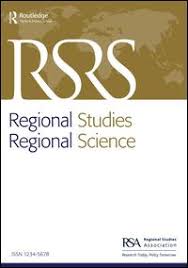
Jones, C., & Jordan, D. (2019). Agglomeration, urbanization and competitive performance: the natural experiment of English football. Regional Studies, Regional Science
There are sound theoretical and empirical bases for expecting productivity and innovative benefits for businesses located in large urban areas, and for those located closer to others in the same or related industries. However, the size and precise origin of these effects remain uncertain and complicated by potential endogeneity from businesses’ location choice. English football is proposed as a natural experiment with immobile businesses and evidence is presented from the English Premier League (EPL) that suggests urban scale affects clubs’ relative performance. It is found that teams in larger conurbations perform relatively better, and it is suggested these benefits probably originate from the sport’s novel labour market.
Full open access text is available here.
There are sound theoretical and empirical bases for expecting productivity and innovative benefits for businesses located in large urban areas, and for those located closer to others in the same or related industries. However, the size and precise origin of these effects remain uncertain and complicated by potential endogeneity from businesses’ location choice. English football is proposed as a natural experiment with immobile businesses and evidence is presented from the English Premier League (EPL) that suggests urban scale affects clubs’ relative performance. It is found that teams in larger conurbations perform relatively better, and it is suggested these benefits probably originate from the sport’s novel labour market.
Full open access text is available here.
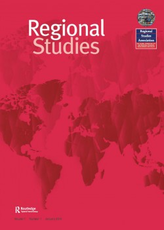
Doran, J & Jordan, D. (2018). The effect of geographical proximity and rivalry on performance: evidence from the English Football League. Regional Studies
Using data on league position for clubs that have participated in English football leagues for 21 seasons, this paper tests, using spatial econometric techniques, whether clubs’ within-season performances are positively affected by better performances of other clubs located geographically closer to them. The paper provides evidence of positive spatial dependence between clubs’ performance. This means that proximity to high-performing clubs drives others to perform better, ceteris paribus. This is consistent with the view in regional analysis that spatial factors are important considerations in understanding business performance.
Full text is available here.
Using data on league position for clubs that have participated in English football leagues for 21 seasons, this paper tests, using spatial econometric techniques, whether clubs’ within-season performances are positively affected by better performances of other clubs located geographically closer to them. The paper provides evidence of positive spatial dependence between clubs’ performance. This means that proximity to high-performing clubs drives others to perform better, ceteris paribus. This is consistent with the view in regional analysis that spatial factors are important considerations in understanding business performance.
Full text is available here.
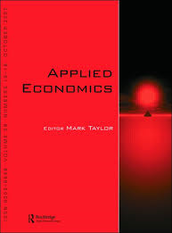
Considine, J & Gallacher, L. (2018). Competitive balance in a quasi-double knockout tournament. Applied Economics
In 2001, the All-Ireland Gaelic Football competition changed from being a singleknockout tournament to a quasi-double knockout competition. Similar natural experiments in economics and operational research theory suggest such a change should reduce the competitive balance in the competition. Using a Hirschmann–Herfindahl Index measure of concentration and a bootstrapping approach, we confirm that the new structure leads to a less competitive outcome and, importantly, this outcome is less uncertain. Our bootstrapped results show that in the long run, with larger samples, there is less competitive balance in the new competition structure than in the older structure competition structure. Finally, we also consider a stochastic dominance approach to evaluating the change in tournament structure, but the low power due to the presence of ties in our small sample leads to an inconclusive outcome.
Full text is available here
In 2001, the All-Ireland Gaelic Football competition changed from being a singleknockout tournament to a quasi-double knockout competition. Similar natural experiments in economics and operational research theory suggest such a change should reduce the competitive balance in the competition. Using a Hirschmann–Herfindahl Index measure of concentration and a bootstrapping approach, we confirm that the new structure leads to a less competitive outcome and, importantly, this outcome is less uncertain. Our bootstrapped results show that in the long run, with larger samples, there is less competitive balance in the new competition structure than in the older structure competition structure. Finally, we also consider a stochastic dominance approach to evaluating the change in tournament structure, but the low power due to the presence of ties in our small sample leads to an inconclusive outcome.
Full text is available here
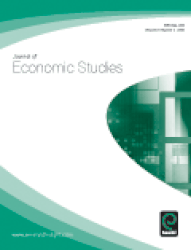
Butler, D., Butler, R., Doran, J, & O'Connor, S. (2018). Explaining International Footballer Selection Through Poisson Modelling'. Journal of Economic Studies, 45 (2)
Growing evidence suggests regional economic factors impact on individual outcomes, such as life expectancy and well-being. This article investigates the impact that player-specific and regional differences have on the number of senior international appearances football players accumulate over their careers, for six UEFA member countries, from 1993 to 2014. The results indicate that both individual and regional variables can explain the number of caps a player receives over the course of their career. We find that an individual's career length positively influences the number of international caps accrued. Players born in wealthier and more populous regions accumulate a greater number of international appearances. Distance from the capital has no effect, however, the number of youth academies in the player’s region of birth has a significant positive effect.
Full text available Spring 2018.
Growing evidence suggests regional economic factors impact on individual outcomes, such as life expectancy and well-being. This article investigates the impact that player-specific and regional differences have on the number of senior international appearances football players accumulate over their careers, for six UEFA member countries, from 1993 to 2014. The results indicate that both individual and regional variables can explain the number of caps a player receives over the course of their career. We find that an individual's career length positively influences the number of international caps accrued. Players born in wealthier and more populous regions accumulate a greater number of international appearances. Distance from the capital has no effect, however, the number of youth academies in the player’s region of birth has a significant positive effect.
Full text available Spring 2018.
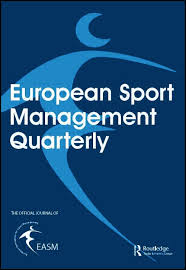
Thibaut, E., Eakins, J., Vos, S., & Scheerder, J. (2017). The determinants and income elasticities of direct and indirect sports expenditure categories. European Sport Management Quarterly, 1-18.
The current study investigates the income elasticities and socio-economic determinants of direct and indirect sports expenditure categories by means of a log normal hurdle regression.The data stem from a representative sample of 3005 Flemish families with school-aged children, gathered through a sports-specific survey. A log normal hurdle regression was used to calculate the determining factors and expenditure elasticities of expenditure on sports participation.The results indicate that income, education and the age of the youngest child are positively related to almost all sports expenditure categories, while the number of family members and degree of urbanisation are significant for only a number of the expenditure categories. The elasticity value of the direct sports expenses is smaller than is the case for indirect sports expenditure. Between the expenditure categories large differences exist, as relatively large elasticities are found for sports holidays, transport and sports food and drinks, as opposed to low values of sports events, sports club membership, entrance fees for sports infrastructure, sports camps, clothing, footwear and equipment. The fact that income significantly influences all expenditure categories demonstrates that further policy intervention is required to make sports consumption more accessible to lower income groups. Sports enterprises and policy-makers need to be aware that negative income shifts have a more profound impact on the indirect expenditure categories, and that certain sports activities (e.g. participation events) are relatively more favoured by low-income groups than is the case for sports club membership.
Full text available here.
The current study investigates the income elasticities and socio-economic determinants of direct and indirect sports expenditure categories by means of a log normal hurdle regression.The data stem from a representative sample of 3005 Flemish families with school-aged children, gathered through a sports-specific survey. A log normal hurdle regression was used to calculate the determining factors and expenditure elasticities of expenditure on sports participation.The results indicate that income, education and the age of the youngest child are positively related to almost all sports expenditure categories, while the number of family members and degree of urbanisation are significant for only a number of the expenditure categories. The elasticity value of the direct sports expenses is smaller than is the case for indirect sports expenditure. Between the expenditure categories large differences exist, as relatively large elasticities are found for sports holidays, transport and sports food and drinks, as opposed to low values of sports events, sports club membership, entrance fees for sports infrastructure, sports camps, clothing, footwear and equipment. The fact that income significantly influences all expenditure categories demonstrates that further policy intervention is required to make sports consumption more accessible to lower income groups. Sports enterprises and policy-makers need to be aware that negative income shifts have a more profound impact on the indirect expenditure categories, and that certain sports activities (e.g. participation events) are relatively more favoured by low-income groups than is the case for sports club membership.
Full text available here.
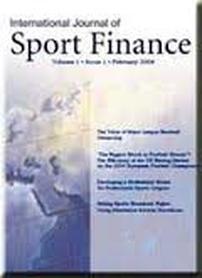
Butler, R., & Butler, D. (2017). Fergie Time and the Allocation of Additional Time: Evidence from the English Premier League 2009 to 2013. International Journal of Sport Finance, 12(3).
This paper examines the impartiality of referee decision making when applying Law 7 of FIFA’s Laws of the Game. We investigate decision making relating to the allocation of additional time for 1,515 English Premier League matches from 2009 to 2013. The research finds no evidence of home favoritism and limited evidence of a bias towards “big” clubs, a phenomenon commonly known as Fergie Time. However, an examination of close matches finds Fergie Time is not present, suggesting its ability to alter tight matches is negligible.
Full text available here.
This paper examines the impartiality of referee decision making when applying Law 7 of FIFA’s Laws of the Game. We investigate decision making relating to the allocation of additional time for 1,515 English Premier League matches from 2009 to 2013. The research finds no evidence of home favoritism and limited evidence of a bias towards “big” clubs, a phenomenon commonly known as Fergie Time. However, an examination of close matches finds Fergie Time is not present, suggesting its ability to alter tight matches is negligible.
Full text available here.
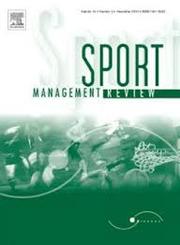
Thibaut, E., Eakins, J., Vos, S., & Scheerder, J. (2016). Time and money expenditure in sports participation: The role of income in consuming the most practiced sports activities in Flanders. Sport Management Review.
Given the recent economic crisis and the risen poverty rates, sports managers need to get insight in the effect of income and other socio-economic determinants on the household time and money that is spent on sports participation. By means of a Tobit regression, this study analyses the magnitude of the income effect for the thirteen most practiced sports by households in Flanders (the Dutch speaking part of Belgium), which are soccer, swimming, dance, cycling, running, fitness, tennis, horse riding, winter sports, martial arts, volleyball, walking and basketball. The results demonstrate that income has a positive effect on both time and money expenditure on sports participation, although differences are found between the 13 sports activities. For example, the effect of income on time and money expenditure is relatively high for sports activities like running and winter sports, while it is lower for other sports such as fitness, horse riding, walking and swimming. Commercial enterprises can use the results of this study to identify which sports to focus on, and how they will organise their segmentation process. For government, the results demonstrate which barriers prevent people from taking part in specific sports activities, based upon which they should evaluate their policy decisions.
Full text available here.
Given the recent economic crisis and the risen poverty rates, sports managers need to get insight in the effect of income and other socio-economic determinants on the household time and money that is spent on sports participation. By means of a Tobit regression, this study analyses the magnitude of the income effect for the thirteen most practiced sports by households in Flanders (the Dutch speaking part of Belgium), which are soccer, swimming, dance, cycling, running, fitness, tennis, horse riding, winter sports, martial arts, volleyball, walking and basketball. The results demonstrate that income has a positive effect on both time and money expenditure on sports participation, although differences are found between the 13 sports activities. For example, the effect of income on time and money expenditure is relatively high for sports activities like running and winter sports, while it is lower for other sports such as fitness, horse riding, walking and swimming. Commercial enterprises can use the results of this study to identify which sports to focus on, and how they will organise their segmentation process. For government, the results demonstrate which barriers prevent people from taking part in specific sports activities, based upon which they should evaluate their policy decisions.
Full text available here.
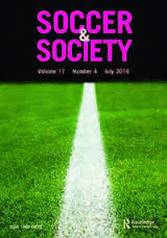
Butler, D., & Butler, R. (2016). Rule changes and incentives in the League of Ireland from 1970 to 2014. Soccer & Society, 1-15.
We consider how five rule changes in the League of Ireland have affected the amount of goals scored in the domestic league from 1970 to 2014. Altering the rules represents a significant departure from the previous season and changes the incentive structure for teams. Numerous individual rule changes were imposed on the league during this period, each with the intention of improving playing standards and incentivizing more attacking football. This paper describes the impact of three new points systems introduced in 1981–1982, 1982–1983 and 1993–1994, the introduction of the First Division League in 1985–1986, and the switch to a single calendar year league with a March–November schedule in 2003 known as Summer Soccer. A retrospective analysis of goals per season and single match outcomes suggests that changes to the points system have not resulted in an increase in the number of goals scored in the Premier Division, nor has the introduction of the First Division.
Full text available here.
We consider how five rule changes in the League of Ireland have affected the amount of goals scored in the domestic league from 1970 to 2014. Altering the rules represents a significant departure from the previous season and changes the incentive structure for teams. Numerous individual rule changes were imposed on the league during this period, each with the intention of improving playing standards and incentivizing more attacking football. This paper describes the impact of three new points systems introduced in 1981–1982, 1982–1983 and 1993–1994, the introduction of the First Division League in 1985–1986, and the switch to a single calendar year league with a March–November schedule in 2003 known as Summer Soccer. A retrospective analysis of goals per season and single match outcomes suggests that changes to the points system have not resulted in an increase in the number of goals scored in the Premier Division, nor has the introduction of the First Division.
Full text available here.
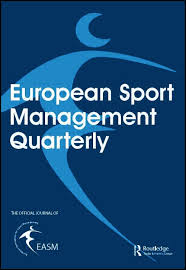
Eakins, J. (2016). An examination of the determinants of Irish household sports expenditures and the effects of the economic recession. European Sport Management Quarterly, 16(1), 86-105.
This study examines the determinants of four household sport expenditure items. The primary objective is to examine the effects of the recent economic recession in Ireland on these expenditures. This study is the first to analyse Irish household sport expenditure data and the first to study the effects of the economic recession on these items. The social and economic characteristics of Irish households affect each sports item in differing ways. The presence of children of a particular age appears to be a strong determinant of spending on categories of sports which involve more physical activity (sport participation and leisure fees). Other categories of sports are influenced more by income (attendance at sporting events) and age and social status (club subscriptions). For some categories of sport spending there is a strong link with how the economy is performing, whereas for others household characteristics play just as important a role.
Full text available here.
This study examines the determinants of four household sport expenditure items. The primary objective is to examine the effects of the recent economic recession in Ireland on these expenditures. This study is the first to analyse Irish household sport expenditure data and the first to study the effects of the economic recession on these items. The social and economic characteristics of Irish households affect each sports item in differing ways. The presence of children of a particular age appears to be a strong determinant of spending on categories of sports which involve more physical activity (sport participation and leisure fees). Other categories of sports are influenced more by income (attendance at sporting events) and age and social status (club subscriptions). For some categories of sport spending there is a strong link with how the economy is performing, whereas for others household characteristics play just as important a role.
Full text available here.
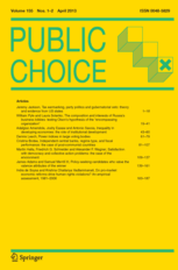
Considine, J., & Doran, J. (2016). Evaluation of an informal rule for the allocation of sports capital funding. Public Choice, 168(1-2), 43-54.
Significant empirical research has highlighted the existence of pork barrel politics. This is where public expenditure is targeted at particular regions based on the logic of collective action: political entrepreneurs maximize their chances of re-election by searching for and implementing programs or projects characterized by ‘concentrated benefits’ for key constituents and broadly dispersed costs. Using data on capital grants to Irish sports teams for 1998–2015, this paper analyzes the extent to which an informal rule can correct this bias. The case of allocating sports capital grants is particularly interesting since academic research, media commentary, and ministerial statements all seem to confirm the existence of political bias with such allocations in Ireland. Specifically, the geographical distribution of the grants are clearly linked to the Minister for Sport: that minister’s constituent county receives significantly higher per capita grant allocation than any other county. The grants were suspended in 2009 because of a fiscal crisis arising from the recession. When the grants were restored in 2012, a new informal rule for allocations was introduced. That informal rule was introduced to reduce the extent of pork barrel politics by ensuring that no county received less than 75 % or more than 150 % of the national average of the per capita grant allocations. The present study evaluated the effectiveness of that informal rule in reducing pork barrel politics in Irish sports capital grant allocations.
Full text available here.
Significant empirical research has highlighted the existence of pork barrel politics. This is where public expenditure is targeted at particular regions based on the logic of collective action: political entrepreneurs maximize their chances of re-election by searching for and implementing programs or projects characterized by ‘concentrated benefits’ for key constituents and broadly dispersed costs. Using data on capital grants to Irish sports teams for 1998–2015, this paper analyzes the extent to which an informal rule can correct this bias. The case of allocating sports capital grants is particularly interesting since academic research, media commentary, and ministerial statements all seem to confirm the existence of political bias with such allocations in Ireland. Specifically, the geographical distribution of the grants are clearly linked to the Minister for Sport: that minister’s constituent county receives significantly higher per capita grant allocation than any other county. The grants were suspended in 2009 because of a fiscal crisis arising from the recession. When the grants were restored in 2012, a new informal rule for allocations was introduced. That informal rule was introduced to reduce the extent of pork barrel politics by ensuring that no county received less than 75 % or more than 150 % of the national average of the per capita grant allocations. The present study evaluated the effectiveness of that informal rule in reducing pork barrel politics in Irish sports capital grant allocations.
Full text available here.
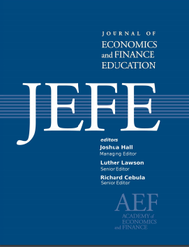
Butler, D., Butler, R., & Considine, J. (2016). What “The Simpsons” Can Teach Us About Sports Economics. Journal of Economics and Finance Education, 12, (2), 88-100.
This paper provides an insight into the teaching of economics. Using sport and The Simpsons one can do some of the heavy lifting when teaching the subject, as these topics generally engage students and provide ample analogies from which one can explore and discuss key economic concepts. The paper does not seek to provide a deep examination of the economics of sport, but merely to illustrate how The Simpsons and sport can be used to teach fundamental economic concepts.
Full text available here.
This paper provides an insight into the teaching of economics. Using sport and The Simpsons one can do some of the heavy lifting when teaching the subject, as these topics generally engage students and provide ample analogies from which one can explore and discuss key economic concepts. The paper does not seek to provide a deep examination of the economics of sport, but merely to illustrate how The Simpsons and sport can be used to teach fundamental economic concepts.
Full text available here.
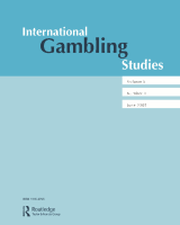
Eakins, J. (2016). Household gambling expenditures and the Irish recession. International Gambling Studies, 16(2), 211-230.
This article examines the determinants of household gambling expenditures in Ireland and the effects of the recession on these expenditures using a large micro data-set, the Irish Household Budget Survey (HBS). Two gambling expenditures are examined, bookmaker tote betting and spending on the national lottery. Households with an older and a less educated head of household participate in and spend more on both forms of gambling while the presence of children in the households tends to reduce participation and spending in gambling. There is also evidence to suggest that households with an unemployed head of household have a higher likelihood of participation in gambling. The recession has affected the two forms of gambling in different ways. Lottery expenditures appear resilient to the effects of the recession. This is demonstrated in the estimated expenditure elasticities in particular. Bookmaker/tote expenditures have changed from a necessity to a luxury good, while lottery expenditures have increased in their necessity status. This can be explained by the fact that playing the lottery requires less time, knowledge and risk and has potentially greater benefits attached to it in comparison to bookmaker/tote betting. During a recession these factors become much more prevalent.
Full text available here.
This article examines the determinants of household gambling expenditures in Ireland and the effects of the recession on these expenditures using a large micro data-set, the Irish Household Budget Survey (HBS). Two gambling expenditures are examined, bookmaker tote betting and spending on the national lottery. Households with an older and a less educated head of household participate in and spend more on both forms of gambling while the presence of children in the households tends to reduce participation and spending in gambling. There is also evidence to suggest that households with an unemployed head of household have a higher likelihood of participation in gambling. The recession has affected the two forms of gambling in different ways. Lottery expenditures appear resilient to the effects of the recession. This is demonstrated in the estimated expenditure elasticities in particular. Bookmaker/tote expenditures have changed from a necessity to a luxury good, while lottery expenditures have increased in their necessity status. This can be explained by the fact that playing the lottery requires less time, knowledge and risk and has potentially greater benefits attached to it in comparison to bookmaker/tote betting. During a recession these factors become much more prevalent.
Full text available here.
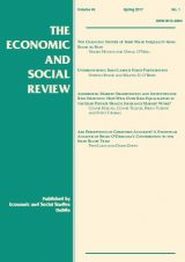
Butler, D., & Butler, R. (2015). The Relative Age Effect and Under-21 Irish Association Football: A Natural Experiment and Policy Recommendations. The Economic and Social Review, 46(4, Winter), 511-519.
A relative age effect refers to the presence of a bias towards relatively older children assembled collectively within a selection year. We consider this in association football (soccer) for Republic of Ireland under twenty-one international footballers over two intervals: from November 1981 to November 1994 and from September 2007 to May 2013. As the registration date for organised soccer in Ireland changed between both periods, these intervals provide scope for a natural experiment to test for a shifting relative age effect. The study confirms the existence of a relative age effect, with a selection bias toward players born in the earlier months of the registration year for both intervals.
Full text available here.
A relative age effect refers to the presence of a bias towards relatively older children assembled collectively within a selection year. We consider this in association football (soccer) for Republic of Ireland under twenty-one international footballers over two intervals: from November 1981 to November 1994 and from September 2007 to May 2013. As the registration date for organised soccer in Ireland changed between both periods, these intervals provide scope for a natural experiment to test for a shifting relative age effect. The study confirms the existence of a relative age effect, with a selection bias toward players born in the earlier months of the registration year for both intervals.
Full text available here.
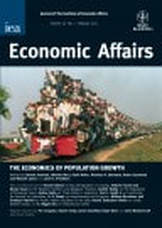
Considine, J., Crowley, F., Foley, S., & O’Connor, M. (2008). Irish national lottery sports capital grant allocations, 1999–2007: Natural experiments on political influence. Economic Affairs, 28(3), 38-44.
rish National Lottery Sports Capital Grant Allocations show a clear bias towards the geographical areas represented by the Minister for Arts, Sports and Tourism and the Minister for Finance. This bias is the result of the procedures by which the funds are allocated.
Full text available here.
rish National Lottery Sports Capital Grant Allocations show a clear bias towards the geographical areas represented by the Minister for Arts, Sports and Tourism and the Minister for Finance. This bias is the result of the procedures by which the funds are allocated.
Full text available here.
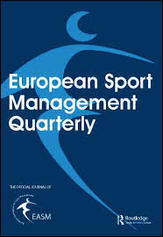
Considine, J., Coffey, S., & Kiely, D. (2004). Irish sports capital funding: A public choice perspective. European Sport Management Quarterly, 4(3), 150-169.
n the last five years, the public funding of large scale sports facilities in Ireland has been the subject of investigations by the Attorney General, the Comptroller and Auditor General and government appointed independent consultants. During the same period there has been a growing scent of sports pork from the allocation of National Lottery funded sports capital grants for smaller sports facilities around the country. Public choice economists, with their assumption of self‐interested political actors pursuing their preferences through the political process, would not be surprised by these events. This paper explains how the public choice perspective offers, the best explanation of sports capital funding in Ireland.
“I am lucky enough to be the first Minister for Finance in over fifty years to bring in an overall Budget surplus. I suppose it is not surprising that the very mention of budget surplus has disturbed the discipline and restraint, which underpin the conditions that led to the budget surplus in the first place.” (Charlie McCreevy in his budget speech of December 2nd 1998)
Full text available here.
n the last five years, the public funding of large scale sports facilities in Ireland has been the subject of investigations by the Attorney General, the Comptroller and Auditor General and government appointed independent consultants. During the same period there has been a growing scent of sports pork from the allocation of National Lottery funded sports capital grants for smaller sports facilities around the country. Public choice economists, with their assumption of self‐interested political actors pursuing their preferences through the political process, would not be surprised by these events. This paper explains how the public choice perspective offers, the best explanation of sports capital funding in Ireland.
“I am lucky enough to be the first Minister for Finance in over fifty years to bring in an overall Budget surplus. I suppose it is not surprising that the very mention of budget surplus has disturbed the discipline and restraint, which underpin the conditions that led to the budget surplus in the first place.” (Charlie McCreevy in his budget speech of December 2nd 1998)
Full text available here.